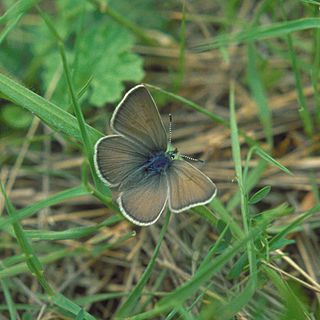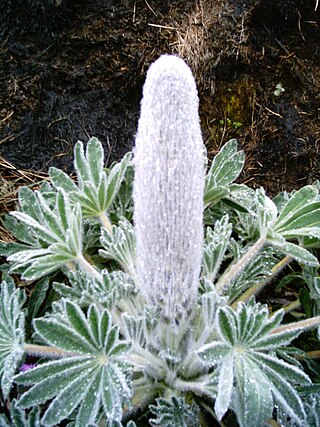
Lupinus polyphyllus, the large-leaved lupine, big-leaved lupine, many-leaved lupine, blue-pod lupine, or, primarily in cultivation, garden lupin, is a species of lupine (lupin) native to western North America from southern Alaska and British Columbia and western Wyoming, and south to Utah and California. It commonly grows along streams and creeks, preferring moist habitats.

Lupinus, commonly known as lupin, lupine, or regionally bluebonnet etc., is a genus of plants in the legume family Fabaceae. The genus includes over 199 species, with centers of diversity in North and South America. Smaller centers occur in North Africa and the Mediterranean. They are widely cultivated, both as a food source and as ornamental plants, but are invasive to some areas.

Lupinine is a quinolizidine alkaloid present in the genus Lupinus of the flowering plant family Fabaceae. The scientific literature contains many reports on the isolation and synthesis of this compound as well as a vast number of studies on its biosynthesis from its natural precursor, lysine. Studies have shown that lupinine hydrochloride is a mildly toxic acetylcholinesterase inhibitor and that lupinine has an inhibitory effect on acetylcholine receptors. The characteristically bitter taste of lupin beans, which come from the seeds of Lupinus plants, is attributable to the quinolizidine alkaloids which they contain, rendering them unsuitable for human and animal consumption unless handled properly. However, because lupin beans have potential nutritional value due to their high protein content, efforts have been made to reduce their alkaloid content through the development of "sweet" varieties of Lupinus.

Lupinus texensis, the Texas bluebonnet or Texas lupine is a species of lupine found in Texas, Louisiana, Arkansas and the Mexican states of Coahuila, Nuevo León, and Tamaulipas. With other related species of lupines also called bluebonnets, it is the state flower of Texas.

Fender's blue butterfly is an endangered subspecies of Boisduval's blue endemic to the Willamette Valley of northwestern Oregon, United States. The potential range of the butterfly extends from south and west of Portland, OR to south of Eugene, OR. The butterfly is host-specific on the Kincaid's lupine, which it relies on for reproduction and growth. The male and female can be identified by their difference in wing color. The Fender's Blue Butterfly was added to the endangered species list in January 2000, but as of February of 2023, has been reclassified as "threatened". The Fender's blue butterfly population has increased over the past 20 years and projected to increase more through conservation efforts. In Willamette Valley, Oregon, there are currently 90 sites filled with Fender's blue.

Lupinus albus, commonly known as the white lupin or field lupine, is a member of the genus Lupinus in the family Fabaceae. It is a traditional pulse cultivated in the Mediterranean region.
Blue lupine is a common name for several plants and may refer to:

Lupinus perennis is a flowering plant in the family Fabaceae.
Lupinus latifolius var. barbatus, the Klamath lupine, sometimes also called bearded lupine, is a very rare plant of the Western U.S., known only from northeastern California and southeastern Oregon. It is a rare variety of the generally common species L. latifolius, which is a member of the bean family.

Lupinus bicolor is a species of lupine known as the miniature lupine, Lindley's annual lupine, pigmy-leaved lupine, or bicolor lupine.

Lupinus excubitus is a species of lupine known as the grape soda lupine. Its common name refers to its sweet scent, which is said to be very reminiscent of grape soda. This species and its variants are found in Southwestern United States, especially in California and Nevada, e.g., Death Valley and Joshua Tree National Parks, and northwestern Mexico.

Lupinus argenteus is a species of lupine known by the common name silvery lupine. It is native to much of western North America from the southwestern Canadian provinces to the southwestern and midwestern United States, where it grows in several types of habitats, including sagebrush, grassland, and forests.

Lupinus rivularis is a species of lupine known by the common name riverbank lupine native to North America. It is also commonly known as river lupine, streambank lupine, and stream lupine.

Lupinus arcticus is a species of flowering plant in the legume family known by the common names Arctic lupine or subalpine lupine. It is native to northwestern North America, where it occurs from Oregon north to Alaska and east to Nunavut. It is a common wildflower in British Columbia.

Lupinus pilosus, commonly known as blue lupine, is a species of flowering plant that is edible from the family Fabaceae that grows in Mediterranean scrubland. It has a 30–70 centimetres (12–28 in) long stem and 3–8 centimetres (1.2–3.1 in) long legume. The species blooms from February to May. The species have white coloured flowers which are 1–1.5 centimetres (0.39–0.59 in) long and pods the diameter of which is 3–8 centimetres (1.2–3.1 in). In Israel the Lupinus pilosus has blue flowers with white vertical spot at the middle.

Lupinus lepidus, the Pacific lupine, prairie lupine or dwarf lupine is a perennial herbaceous plant in the pea family (Fabaceae) native to western North America.
Lupinus garfieldensis, commonly known as the Garfield lupine or the Asotin Silky lupine, is a species of lupine native to eastern Washington state.
Lupinus mexicanus, also known as the Mexican lupin, is a species of lupine native to Mexico and introduced in Malawi, Tanzania, and Zimbabwe. Some sources say it was introduced to India, too.

Lupinus hispanicus, commonly known as the Spanish lupine, is a species of lupine native to Iberia.

Lupinus alopecuroides is a species of lupine native to the mountain peaks of Colombia and Ecuador.















